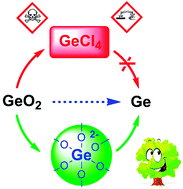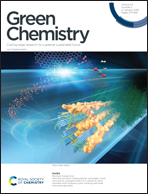An environment-friendly approach to produce nanostructured germanium anodes for lithium-ion batteries†
Abstract
In this paper, we propose a halogen-free process for the preparation of germanium micro-scale particles with a nano-structured surface morphology from germanium citrate, an easily accessible and environment-friendly precursor formed from germanium dioxide and citric acid in an aqueous medium. Electrodeposition of nanostructured Ge anodes on copper foil was performed via electrolysis of 1–5% germanium citrate solution in propylene glycol with addition of 5% acetic acid. Cyclic voltammetry data suggested that germanium citrate is an electrochemically inactive compound, but readily undergoes reduction by cathodic hydrogen released in the electrolysis. Such behaviour allows one to run the electrolysis under simple galvanostatic conditions without any need for controlling the potential. Furthermore, no diaphragm is required to separate the cathodic and anodic cell compartments. The electrodeposition produces black and compact films composed of ∼200 nm germanium particles, which, in turn, consist of nanoparticles no larger than 25 nm in size (SEM and TEM data). XRD and Raman spectroscopy data lead to the conclusion that germanium precipitates in the amorphous phase; however, with an increase in the power of the He–Ne laser (632.8 nm) during Raman spectra recording, it transforms into a nanocrystalline form. Testing germanium anodes in lithium-ion half-cells showed a specific capacity of ∼600 mA h g−1 at 1–2C current rates, which is comparable to the best results achieved for Ge anodes produced using more sophisticated and less environment-friendly techniques.



 Please wait while we load your content...
Please wait while we load your content...